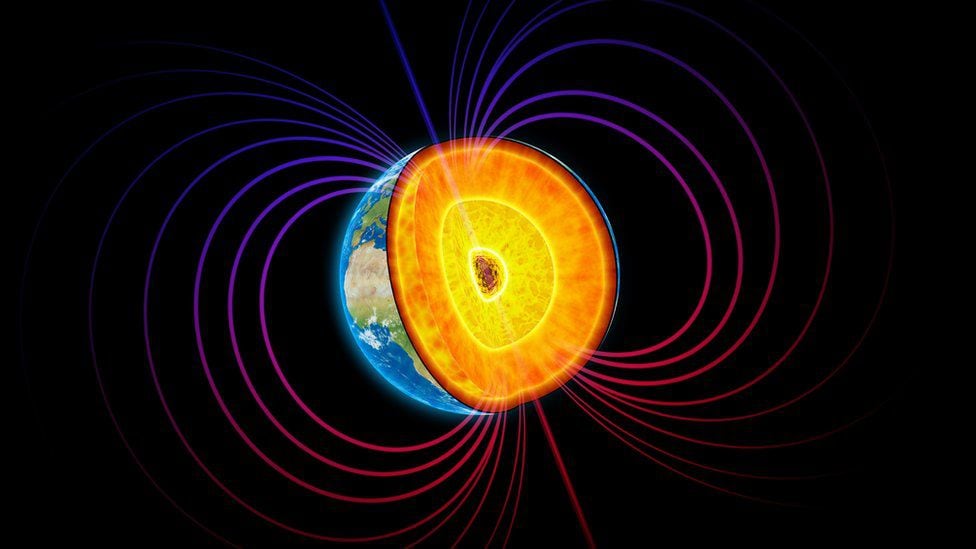The center of the Earth is one of the great mysteries of science.
In recent decades, scientists have begun to have some certainty about what the heart of our planet is like and how it behaves.
LOOK: The study that indicates that the Earth’s core slowed down; what could happen?
And it is that studying it directly is now impossible: the investigations that have gone the furthest have managed to drill at a depth of about 12 kilometers, and the core of the planet is more than 5,000 km.
A few days ago, a new investigation was published whose conclusions, if confirmed, offer a different perspective on what is happening in the depths of the Earth and how it can affect us.
The study scientists believe that the core at the center of the planet is slowing down its rotation or may even have begun to spin in the opposite direction.
But what does that mean and how important is it?
The layers of the earth
To understand the new theory, one must first review what is known about the center of the planet.
Scientists have come to determine that the structure of the planet consists of three main parts: the bark (or surface), the mantle and the planet core.
An easy way to think of it is to compare it to an egg: Earth’s crust is like the shell, its mantle is like the white of an egg, and the core is like the yolk.
The inner core is known to be a sphere of iron and nickel with a radius of 1,221 kilometers. Its temperature of 5,400°C is almost as high as that of the Sun (5,700°C).
But it is so deep that it remains a solid sphere of metal.
Previous research has shown that the core is separated from the rest of the Earth by a outer layer of liquid metal, or outer core. This means that the internal can spin independently and not necessarily in sync with the rest of the planet.
But understanding exactly how it rotates has been the subject of debate among scientists for decades.
changes in the core
To watch seismic waves caused by earthquakesscientists have a better idea of what is happening in the center of the planet without the need to drill.
Large earthquakes occur in regions of the Earth’s crust and send energy through the planet, which can bounce back to the surface.
So scientists at Peking University Song Xiaodong and Yang Yi they were studying seismic waves for several years. By tracing the paths of these waves, they found that there had been “little change in the last decade.”
Their findings translate into the rotation of the inner core of the Earth has stopped and that, over the decades, it has been turning first in one direction and then in another, possibly in a cycle.
According to their findings, the last time it changed direction was in the early 1970s and the next change would occur in the mid-2040s.
Thus this rotation roughly coincides with changes in day lengths, which are small variations in the exact time it takes the Earth to rotate on its axis.
How does this affect us?
Changes within the Earth’s core have an impact on the surface on which we live. They have the ability to alter things like navigation and even the length of the day, albeit imperceptibly.
And that is due to magnetic field.
Our planet is always spinning in space, and at its center, Earth’s metallic core is also spinning. These movements create a magnetic force that surrounds the Earth, that is, its magnetic field.

Earth’s magnetic field protects the planet from radiation from the Sun, but it also influences how fast or slow the planet spins on its axis.
In other words, it can change how long our days are.
The fact that the days have had a different length over time is something that was already known.
“Thanks to the geological record, and especially to the study of the growth layers of fossil corals, it is known that years in the geological past lasted more days. That is, the Earth rotated faster, and therefore the days were shorter. In the Mesozoic, the days lasted 23 hours,” explained the Institute of Geosciences of the Complutense University of Madrid.
When the days slow down, it’s just a fraction of a millisecond.
But it’s enough that, like a leap year, it has taken about 27 leap seconds since the 1970s to keep our clocks accurate.

The speed of the Earth’s rotation on its axis is believed to have changed continuously throughout history. due to the change in the spin of the inner core.
The movement of the Earth’s magnetic north pole has accelerated so much in recent years that they have had to perform commercial and military aircraft navigation modifications.
But determining how much could be changing in recent years is something that is under discussion with research such as Song Xiaodong and Yang Yi.
Some scientists even suggest that the work of these scientists It must be complemented with more studies before reaching conclusions.
John Vidale, a geophysicist at the University of California, who was not involved in this study, says “something is going on” in the Earth’s core but more evidence is needed.
“We will determine, but it may take a decade,” he said.
Source: Elcomercio
I am Jack Morton and I work in 24 News Recorder. I mostly cover world news and I have also authored 24 news recorder. I find this work highly interesting and it allows me to keep up with current events happening around the world.

:quality(75)/cloudfront-us-east-1.images.arcpublishing.com/elcomercio/GE2TEMZNGAYS2MRVKQYDAORRGU.jpg)

:quality(75)/cloudfront-us-east-1.images.arcpublishing.com/elcomercio/DWRZQ5TAV5BCFNLBSEMDZTUG6I.jpg)
:quality(75)/cloudfront-us-east-1.images.arcpublishing.com/elcomercio/B3NHNKRPUFHD3GLNBNMD2HYZQU.JPG)
:quality(75)/cloudfront-us-east-1.images.arcpublishing.com/elcomercio/EWTQS7L2H5ENVDYE24TBNRNFLU.jpg)

